2021 State Energy Virtual Conference Connects the Clean Energy Community in North Caorlina
Last week, hundreds of clean energy professionals joined the NC Clean Energy Technology Center (NCCETC) for the virtual 2021 State Energy Conference of North Carolina (SEC). SEC had over 30 sessions to choose from in six different tracks: Commercial & Industrial Buildings, Governmental & Institutional Buildings, Residential Homes, Renewable Energy, Grid Edge and Utilities & Infrastructure.
Attendees came from a variety of backgrounds, including state and local government, non-profits, startups, academia and corporate organizations – joined under the SEC’s theme: “Connecting North Carolina’s Diverse Energy Economy.”
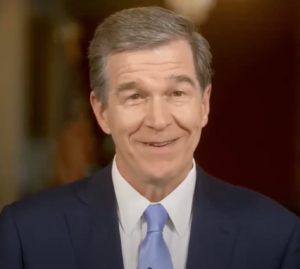
“On top of creating job opportunities, transitioning to a clean energy economy is helping us fight one of the greatest challenges of our lives – climate change,” Governor Roy Cooper (pictured left) said, as he kicked off the SEC on the first day of live sessions. Governor Cooper urged conference attendees to add their voice to the discussion to brainstorm how North Carolina can continue being a leader in clean energy.
Attendees were able to be a part of the clean energy discussion over three days of live sessions where they listened to and connected with industry leaders, sharing their own ideas and questions about North Carolina energy’s present and future. Conference sessions covered a wide range of energy topics focused on best practices and case studies about existing, emergent and innovative technologies, energy policy, commercial, industrial & institutional buildings, grid modernization, residential homes, renewable energy and utilities and infrastructure.
How Technology is Helping North Carolina Meet Climate Goals
The “Cleantech, Carbon and Policy: How Technology Is Helping North Carolina Meet Climate Goals” session was a part of the Grid Tech track. The session panelists discussed how current and future clean energy technologies will enable North Carolina to meet and surpass climate goals.

The town of Boone, North Carolina is already working toward its own set of goals, including for the entire town to be run on clean, renewable energy by 2050. According to Boone’s Town Manager John Ward (pictured right), the town is conducting efficiency studies in all of their departments to help offset energy use.
“At our wastewater treatment facility, we were able to do an energy efficiency study through assistance with the Department of Environmental Quality and identified quite a few upgrades,” Ward said. “We’ve already done a 20 percent reduction in the energy use in that facility.”
De-risking Energy Infrastructure Projects
In the Utilities & Infrastructure track, the session “De-risking Energy Infrastructure Projects” tackled issues the region’s energy infrastructure builders are facing today and how they may develop appropriate solutions to complete projects on time and to the satisfaction of the asset owner, its stakeholders and the community.
Nelson Peeler, Chief Transmission Officer at Duke Energy, stressed how important communication and transparency with stakeholders, community members and regulators is important even at the early stages of infrastructure planning.
Vice President and Program Manager of Wood PLC’s Steve Kiser echoed Peeler’s early engagement approach. “Get input from the community well in advance of the early stages of development for the project to make them feel a part of that process and that their input is valued,” Kiser said.
On-Demand: Developing the Future of North Carolina’s Clean Energy Industry and Workforce
Before live sessions began, NCCETC released 12 on-demand sessions available to all who registered for the conference. An on-demand session in the Renewable Energy track, “Developing the Future of North Carolina’s Clean Energy Industry and Workforce”, discussed how, in order for North Carolina’s clean energy industry to grow and thrive, it must tap into all the talent in our state– including underutilized communities such as women and people of color.
“We can create an ecosystem that supports all people and supports people where they are,” NCCETC’s Training Specialist Allison Carr said. “Whether they need training or need professional development and networks, this ecosystem can support the connection of potential employees with the energy employers looking for the skilled workforce they need.”

Organizations can also diversify their operations through supplier diversity, a proactive business program that encourages organizations to source their supplies from diverse suppliers, or a business that is at least 51 percent owned and operated by an individual or group that is part of a traditionally underrepresented or underserved group, explained Robyn Hamilton (pictured left), Supplier Diversity Manager of Self-Help Credit Union explained.
Self-Help Credit Union’s mission is to create and protect ownership and economic opportunity for all and they are committed to using its power of influence to positively impact individual businesses’ ability to grow their capacity. Through their partnerships, they strive to create opportunities for disadvantaged communities. Melissa Malkin-Weber, Sustainability Director for Self-Help Credit Union, discussed how diversity in communities and businesses lead to better and more informed solutions, as well as a more profitable clean energy economy.
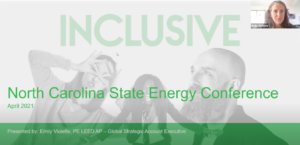
For Schneider Electric, a global and inclusive mindset is critical for both their internal and external operations. Schneider Electric’s Global Account Executive Emily Violette (pictured right) stated, “Our DEI Ambition is to ‘provide equal opportunities to everyone everywhere and to ensure all employees feel uniquely valued and safe to contribute their best.”
Externally, Schneider Electric also promotes and delivers energy infrastructure “everywhere, for everyone and at every moment”. Violette said, “Reaching areas that are not developed as well as expanding on areas that are developed is critical to both our mission and the success of our business.”
Keynote Speakers
Biographies for all of the conference’s keynote speakers are available on the conference website. Sharon Allen, Chief Strategy and Innovation Officer of the Smart Electric Power Alliance (SEPA) and Karen Wayland, CEO of GridWise Alliance delivered the SEC’s opening keynotes.
SEPA is a non-profit organization with the mission to facilitate the electric power industry’s smart transition to a clean and modern energy future. Over 1000 members across the country and planet, 700 of which are utilities, rely on SEPA’s advice and guidance in the critical transformation of the energy sector.
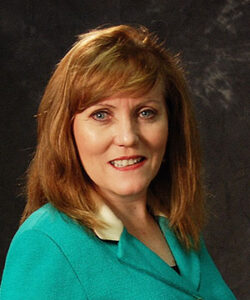
Sharon Allen (pictured left) explained that equity and resilience has come to the forefront of clean energy conversations. According to her, the clean energy industry’s transition must be just and support all communities, especially those that are disproportionately affected by worsening natural disasters.
“[North Carolina] has had 81 storms costing over $1 billion dollars since 1980,” Allen noted. As renewable energy continues to increase across the nation, it must be able to recover and adapt to supply resilient and reliable energy.
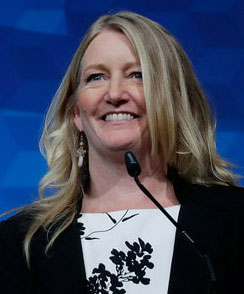
“The intensity and severity of storms in 2020 was unparalleled,” GridWise’s Karen Wayland (pictured right) said. She focused on how addressing the climate crisis also means addressing vulnerabilities in the electrical grid. GridWise Alliance’s mission is to champion the principles, policies and investments needed to transform the electricity grid by understanding the diverse perspectives and priorities of all stakeholders.
Wayland urged a significant investment in upgrading America’s grid. “We also, and Sharon mentioned this, we need to employ grid enhancing technologies to make the grid smarter, more secure and more resilient.” Wayland listed charging infrastructure for electric vehicles, integration of renewables and technologies to enhance the grid’s flexibility as priorities for modernizing the current grid.
Offshore Wind Opportunity for the Mid-Atlantic
The “Offshore Wind Opportunity for the Mid-Atlantic” keynote plenary focused on what the east coast has to gain from the burgeoning offshore wind industry as more states invest in this emerging technology.
According to a report released by the NC Department of Commerce earlier this year, North Carolina has a chance to attract a significant portion of more than $100 billion market opportunity. The report was commissioned by the NC Office of Science, Technology & Innovation, an operating unit of the Commerce Department. The report was published by BVG Associated and its lead team included experts from Lloyds Register Energy Americas, Timmons Group, and North Carolina State University and NCCETC.
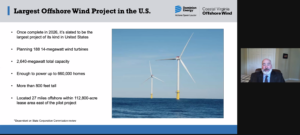
“There is a great need… to have skilled workers- engineers, lawyers, accountants- and working together we can make sure that the pipeline remains full so that we can competitively move forward with construction and operations of these projects,” John Larson (pictured left), Director of Public Policy & Economic Development for Dominion Energy, noted.
Collaboration was a focus of the panel, with panelists agreeing that partnerships will enhance the offshore wind industry in a variety of ways in the coming years. Recently, the governors of North Carolina, Virginia and Maryland agreed to cooperatively promote, develop and expand offshore wind energy generation and the accompanying industry supply chain and workforce.
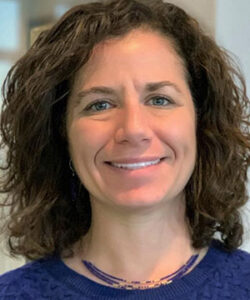
“If we work together, we can be that much more successful and that much more powerful in our endeavors in trying to advance offshore wind development along our shared coast,” said the Senior Policy Advisor for the NC Department of Environmental Quality (NC DEQ), Jenifer Mundt (pictured right). A partnership between states can improve regulatory certainty so that state legislature affecting offshore wind can be made in alignment to limit any administrative burdens.
What’s going on at the Legislature?
The keynote plenary “What’s going on at the Legislature?” brought together panelists from both the private and public sector to discuss the current legislative actions under consideration.
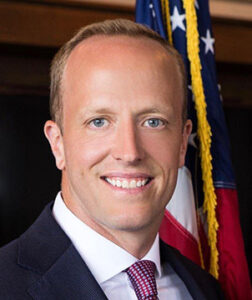
“The only thing that’s constant in my time working on energy is that everything is changing and things seem to be continuing to change even faster; the cost of renewable energy and the cost of batteries continues to plummet,” Alexander C. Miller (pictured left) expressed. With this change, Miller notes, North Carolina can lead through legislation by maintaining the progress we’ve already had and expanding opportunities for future progress.
Knowing about the change, however, is only half the battle. Duke Energy’s Kevin McLaughlin said, “We have a chance to get ahead of what’s coming and implement a balanced transition strategy that prioritizes affordability and reliability while bringing on clean energy.”
The clean energy transition cannot be approached as a ‘one size fits all’, and stakeholders, community members and workers must come together with the legislature to ensure the transition can benefit all who are involved.
North Carolina’s Clean Energy Future
The conference’s last keynote plenary “North Carolina’s Clean Energy Future” evaluated how we will move forward to meet ambitious climate goals and reduce greenhouse gasses while driving innovation and workforce development.

One of the NC DEQ’s Clean Energy Plan’s goals is to accelerate clean energy innovation, development and deployment to create economic opportunities for both rural and urban areas of the state. “We are working with community colleges and universities to bring opportunities from K-12 and beyond for energy education and workforce development,” said Sushma Masmore (pictured right), Acting Assistant Secretary for Environment at the NC DEQ.
As part of this project, NC DEQ is launching a pilot program in Wake, Halifax and Guilford County where entry-level college students can attain apprenticeship and internship opportunities in the clean energy field to gain hands-on experience.
Conference Wrap-Up
In addition to comprehensive sessions, keynotes and plenary panels, attendees enjoyed virtual networking sessions and had the chance to earn continuing education credits through session attendance.
Steve Kalland, executive director with the NCCETC, found three key takeaways at this year’s SEC. The first theme he identified is that change is not slowing down, but accelerating, and he expects a lot of change to come fast in the clean energy sector. Kalland also noted his second takeaway, “Resilience was the new buzzword this year; whether you were talking about grid operations, energy storage and reliability or infrastructure.”
The last theme Kalland identified for this and next year’s State Energy Conference was one of collaboration. As the country works toward the common goal of being carbon free by 2050, professionals from the clean energy industry and beyond all have something to contribute during this transition.
New for this year’s virtual conference, those who register online can access all of the sessions for two weeks after the conference has concluded. Both on-demand and recorded live sessions are available online, as well as 30 minutes hot topics sessions. To access hours of content from industry experts, register now.Save the date for the 2022 State Energy Conference, April 26-27, 2022! Learn more at www.ncenergyconference.com.